Bernard Parmegiani facts for kids
Quick facts for kids
Bernard Parmegiani
|
|
|---|---|

Parmegiani in 2004
|
|
| Born | 27 October 1927 Paris, France
|
| Died | 21 November 2013 (aged 86) Paris, France
|
| Occupation | Composer |
| Years active | 1964–2013 |
Bernard Parmegiani (born October 27, 1927 – died November 21, 2013) was a French composer. He was famous for his electronic music, which is often called acousmatic music. This type of music is made using sounds that are recorded and then played back, often in a concert hall, without seeing the instruments or performers.
Contents
Who Was Bernard Parmegiani?
Bernard Parmegiani was a very creative French composer. He made music using electronic sounds and recordings. His work influenced many other artists.
Early Life and Studies
From 1957 to 1961, Bernard Parmegiani studied mime with a teacher named Jacques Lecoq. Mime is a type of acting without words, using only body movements. He later said that learning mime was very important for his music.
In 1959, he joined a special music group called the Groupe de Recherches Musicales (GRM). This group was started by Pierre Schaeffer, who was a pioneer in electronic music. Parmegiani took a two-year master class there to learn more about sound and composition.
Working in Television
After his mime studies, Parmegiani first worked as a sound engineer. Later, he became the head of the Music/Image unit for French television (ORTF). In this job, he worked with other famous composers like Iannis Xenakis.
While at ORTF, Parmegiani created music for many films. He worked with directors like Jacques Baratier and Peter Kassovitz. He also made music for a short animated film called A in 1965.
You might have heard his work without knowing it! He wrote many short musical tunes, called jingles, for French media. He also created the "Indicatif Roissy" sound. This sound played before every announcement at Terminal 1 of Charles de Gaulle Airport in Paris until 2005.
Creating New Music
In 1964, Parmegiani composed his first big work called Violostries. This piece was for violin and tape recordings. It was used for a dance show.
In the late 1960s, he visited America to study how music and video could work together. When he came back, he made several music videos. These included L'Œil écoute and L'Écran transparent (1973).
During the 1970s, Parmegiani also started performing live jazz music. He even played with a band called the Third Ear Band in London.
At this time, he also began writing "acousmatic" pieces for concert halls. These pieces were meant to be heard without seeing the musicians. Examples include Capture éphémère (1967), which explores the idea of time passing. Another was L'Enfer (1972), which he made with composer François Bayle. This piece was based on Dante's famous poem, Divine Comedy.
Parmegiani also composed music for films by Walerian Borowczyk. These included Jeux des Anges (1964) and Docteur Jekyll et les femmes (1981). For the second film, he used parts of his earlier work from 1972.
Later Years and Influence
In 1992, Parmegiani left the GRM group. He then opened his own music studio in Saint-Rémy-de-Provence. In 2010, he was a judge at the sixth Qwartz Electronic Music Awards. This event helps new electronic music artists.
Bernard Parmegiani has inspired many younger experimental musicians. Famous artists like Aphex Twin, Autechre, and Sonic Youth have said he was a major influence on their work. His music was even played at the All Tomorrow's Parties festivals in 2003 and 2008.
Awards and Recognition
Bernard Parmegiani's music won many awards.
- In 1979, he received prizes from the Académie du Disque Français.
- In 1981, he won an award from SACEM.
- In 1990, he received a prize from Les Victoires de la Musique.
- In 1991, he won the Prix Magister at the Concours International de Bourges.
- In 1993, he was given the Golden Nica Award at Prix Ars Electronica for his piece Entre-temps, which he composed in 1992.
Key Compositions
Here are some of Bernard Parmegiani's important musical works:
- 1964 Violostries
- 1965 La Brûlure De Mille Soleils
- 1967–1968 L'Instant mobile, Capture éphémère
- 1968 "Pop eclectic" (for the film "Je, tu elles")
- 1970 L'Œil écoute
- 1971 La roue ferris
- 1971 L'Enfer (based on Dante's Divine Comedy)
- 1972 Chronos
- 1972 Pour en finir avec le pouvoir d'Orphée
- 1974 Chants Magnétiques
- 1975 De Natura Sonorum
- 1977 Dedans-Dehors
- 1980 L'Echo du miroir
- 1984 La Création du monde
- 1985–1986 Exercismes 1 – 2 – 3
- 1991 Le Présent composé
- 1992 Entre-temps
- 1996 Sonare
- 2002 La mémoire des sons
- 2004 Espèces d'espace

